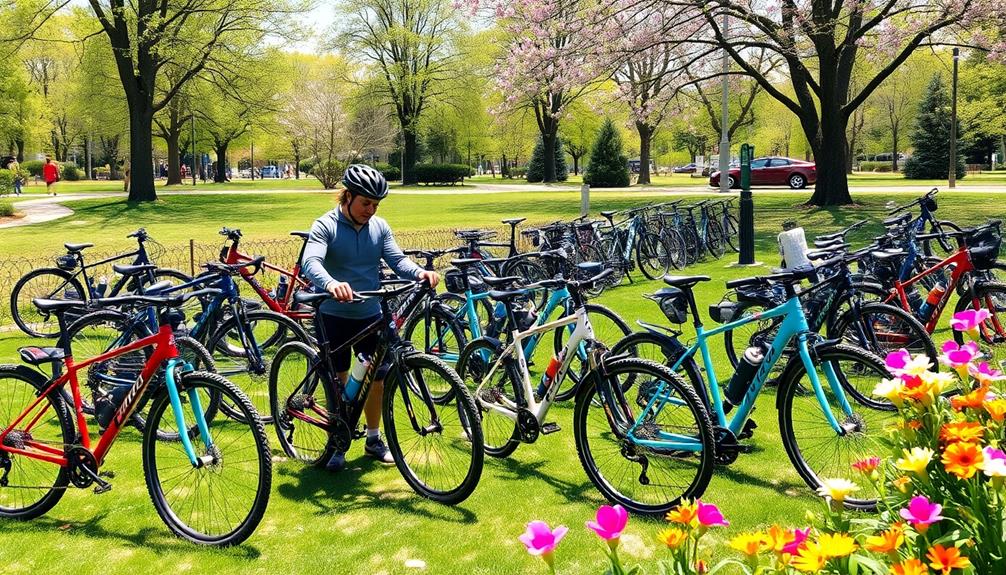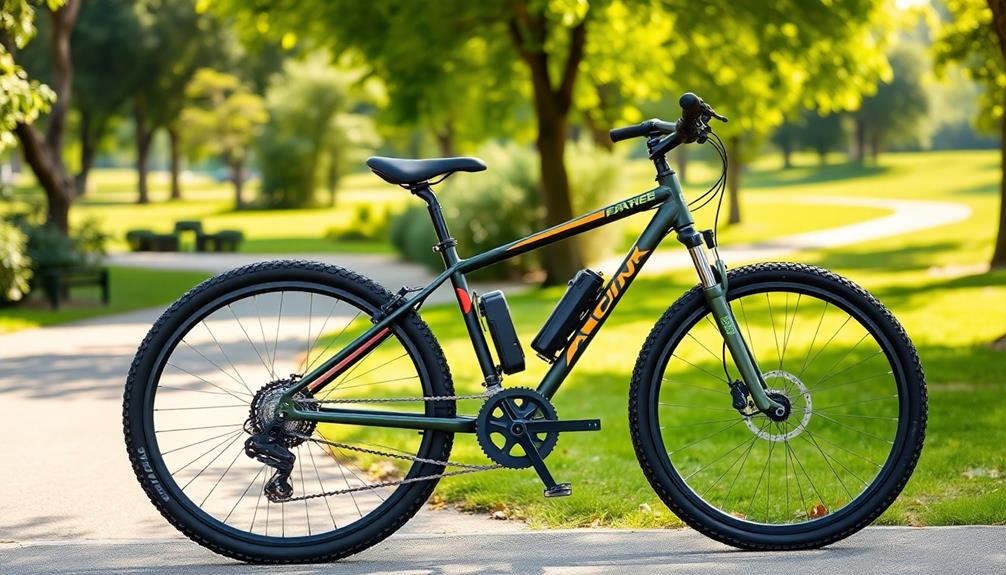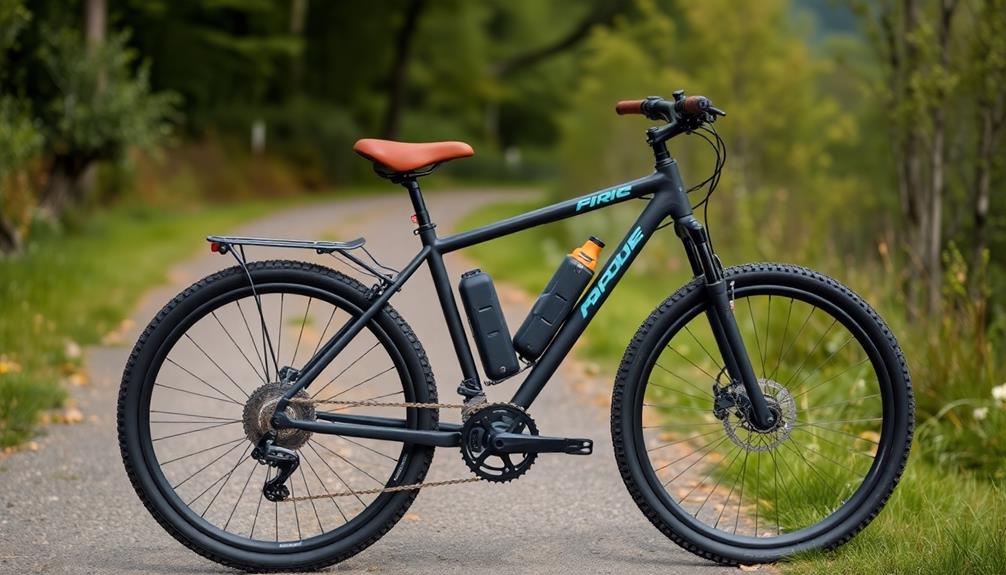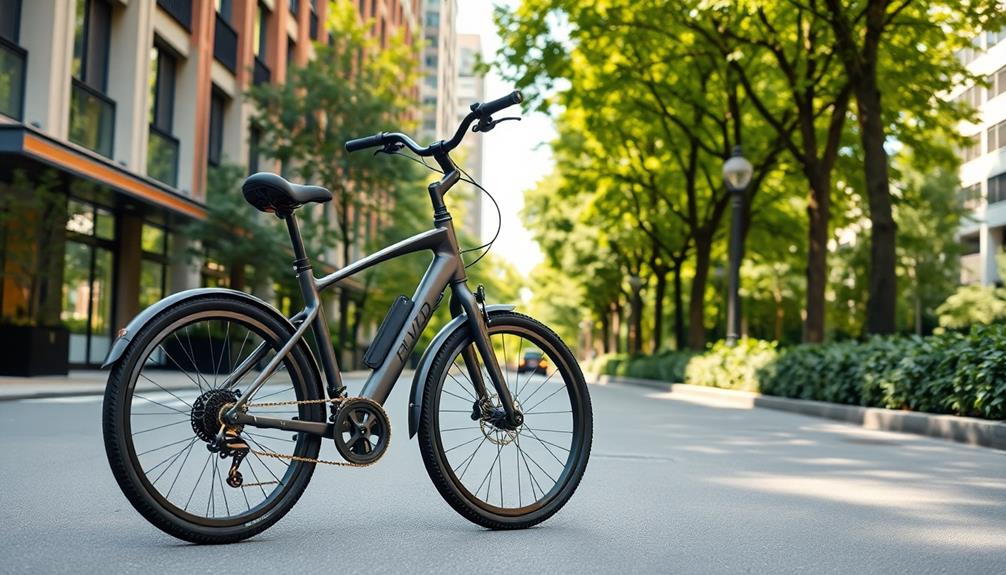Choosing your first hybrid bike is all about knowing what you need. Start by considering the frame materials — aluminum is lightweight, while steel offers durability. Comfort is key, so pick a geometry that feels good for you. Think about gearing options too; single-speed bikes are great for flat areas, but multi-speed ones offer versatility on hills. Evaluate brake types; disc brakes provide better performance in wet conditions. Finally, set a budget and remember to allow for safety accessories like lights and a helmet. Keep exploring to discover how each feature can enhance your riding experience.
Key Takeaways
- Consider frame materials like aluminum for lightweight options or steel for durability based on your riding needs.
- Assess the geometry for comfort; a relaxed, upright design enhances stability.
- Choose gearing systems that match your terrain; single-speed is best for flat areas, while multi-speed suits hilly rides.
- Evaluate brake types; disc brakes provide superior stopping power in various conditions compared to rim brakes.
- Properly size the bike based on your inseam length for optimal comfort and performance; test rides are recommended.
Understanding Hybrid Bikes
When you're considering a hybrid bike, it's essential to understand what sets it apart from other types of bicycles. Hybrid bikes blend features from both road and mountain bikes, making them perfect for versatile terrains like city streets and light trails.
Their comfortable upright position and flat handlebars provide better control, enhancing your riding experience. Additionally, some hybrid bikes come equipped with electric assist options, which can make longer rides or challenging terrains more manageable for riders of all skill levels. This versatility is similar to what you find in electric one up bikes that cater to varied riding preferences.
You'll also notice the tire width, typically ranging from 28-42mm, which improves stability and comfort on bumpy surfaces. The choice of frame materials can affect ride quality; aluminum offers lightweight durability, carbon caters to high-end performance, and steel enhances comfort and shock absorption.
When it comes to gearing systems, hybrid bikes vary widely. You can opt for a single-speed setup for flat terrains or choose multi-speed options with over 27 gears for hilly areas, enhancing your climbing ability.
Brake types are another consideration: rim brakes are economical and easy to maintain, while disc brakes—both mechanical and hydraulic—offer superior performance in different weather conditions, ensuring a safer ride.
Understanding these elements will help you choose the right hybrid bike that suits your riding style and needs.
Key Features to Consider
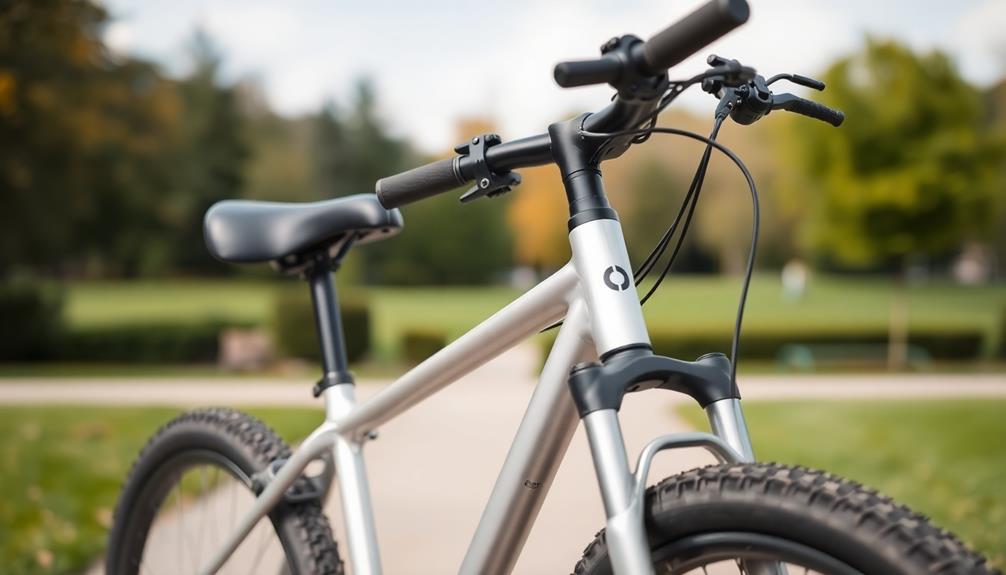
When choosing your first hybrid bike, it's crucial to focus on key features like frame materials and geometry, gearing systems, and brake types.
For instance, understanding the importance of changing gears smoothly can help you maintain cadence and momentum on varying terrains.
Each of these elements can greatly impact your riding experience, whether you're commuting in the city or exploring rugged trails.
Understanding your preferences will help you make the best choice for your needs.
Frame Materials and Geometry
Choosing the right frame material and geometry is essential for your comfort and performance on a hybrid bike. The most common frame materials include aluminum, which is lightweight and affordable; carbon fiber, used in high-end models for its excellent strength-to-weight ratio; and steel, known for its durability and shock absorption. Each material offers unique benefits, so consider what matters most to you.
Additionally, understanding the importance of color accuracy in projectors can help you appreciate how materials impact overall performance in different contexts.
When it comes to geometry, hybrid bikes typically feature a more relaxed and upright design, prioritizing rider comfort and stability. Look for a slacker head tube angle, which enhances stability and control, making it easier to navigate various terrains, from city streets to light off-road paths.
Frame size is vital for ensuring a comfortable ride, so measure your inseam length and consult sizing charts from manufacturers.
Additionally, pay attention to chainstays: longer chainstays improve stability for a smoother ride, while shorter ones enhance maneuverability for agile handling.
Gearing Systems Overview
After selecting the right frame for your hybrid bike, it's time to contemplate the gearing system that best matches your riding style and terrain. Gearing systems play an essential role in your bike's performance, especially if you plan to tackle varied landscapes.
If you're riding mostly flat terrains, single-speed options might suffice. However, if you expect hills and diverse conditions, consider multi-speed configurations with up to 27 gears. For example, much like how suspension upgrades enhance ride quality in Chevrolet tuning, the right gearing can greatly improve your biking experience on different terrains.
You'll find common setups like 1X, 2X, or 3X chainrings, which let you choose a configuration that suits your fitness level and the routes you'll take. A wider gear range is vital for best performance, as it allows for smooth changes between speeds, improving control on inclines and declines.
Most hybrid bikes feature derailleur-based multi-speed systems, offering a blend of efficiency and versatility. Alternatively, internally geared hubs, typically providing 3 to 8 speeds, are low-maintenance options that keep your gears protected from the elements, making them ideal for casual riders.
Ultimately, selecting the right gearing system is key to enhancing your biking experience.
Brake Types Comparison
Brakes are an essential component of any hybrid bike, directly impacting your safety and control on the road. When choosing between brake types, you'll want to evaluate your riding conditions and performance needs.
For example, AI technologies improve threat detection in various applications, which can metaphorically relate to how effective braking systems enhance rider safety.
Rim brakes are economical and lightweight, making them easy to maintain. However, they can struggle in wet weather, so they're best for dry commutes and casual rides.
On the other hand, disc brakes—available in mechanical and hydraulic versions—offer superior stopping power in various weather conditions.
Hydraulic disc brakes use fluid for force transfer, providing stronger stopping power with less maintenance, making them an ideal choice if you prioritize performance and safety.
Mechanical disc brakes, while offering better performance than rim brakes, require manual adjustments for wear, making them slightly more maintenance-intensive.
Ultimately, if you plan to ride in mixed terrains or wet weather, disc brakes are highly recommended. For flat, dry rides, rim brakes may suffice.
Assess your riding style to choose the brake type that fits your needs, ensuring you have the control and safety necessary for enjoyable rides.
Choosing the Right Size
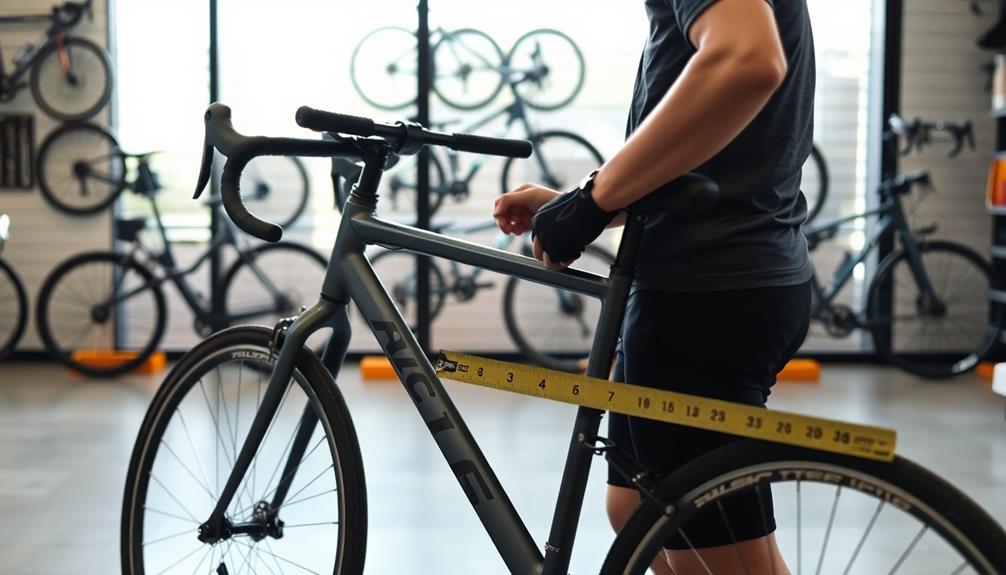
Finding the right size hybrid bike is vital for comfort and performance, so start by measuring your inseam. Stand against a wall with a book between your legs and mark the height; this measurement helps you determine the appropriate frame size.
Hybrid bike sizing typically ranges from 15/XS to 23/XL, with specific inseam ranges for each size, ensuring ideal comfort and performance. Additionally, consider exploring electric bike conversion kits, such as the PEXMOR Electric Bike Conversion Kit, which can enhance your hybrid bike's performance for urban commuting.
A proper fit means you should have a slight bend in your knee when the pedal is at its lowest point, which promotes efficient pedaling and reduces injury risk. Test riding different sizes is essential. If you find yourself between sizes, consider your comfort, riding style, and intended use to make your final decision.
Many bike manufacturers provide sizing charts on their websites, making it easier to select the right size based on your inseam, torso, and arm length measurements.
Assessing Gearing Options

Once you've settled on the right size for your hybrid bike, it's time to contemplate the gearing options that best suit your riding style and terrain. If you often ride in urban areas or flat terrains, a single-speed bike might be ideal for you. It simplifies maintenance and offers efficiency for urban commuting.
However, if you plan to tackle steep climbs or varied terrains, consider a multi-speed system. A bike with at least a 3-speed gear configuration can greatly enhance your riding experience by providing flexibility for different inclines. The versatility of hybrid bikes allows for a range of gearing options that cater to both recreational and practical uses, making them suitable for various cycling needs, including commuting efficiency.
Most hybrid bikes feature derailleur-based gearing systems, which strike a balance between performance and ease of use. Alternatively, you might opt for internally geared hubs, which offer low maintenance and smoother shifting.
A wider gear range, such as a 32-tooth sprocket, is essential for efficiently managing steep climbs while maintaining speed on descents. Ultimately, your choice of gearing options should align with your specific needs, whether you're a casual rider seeking simplicity or a more serious cyclist wanting versatility.
Evaluating Brake Types
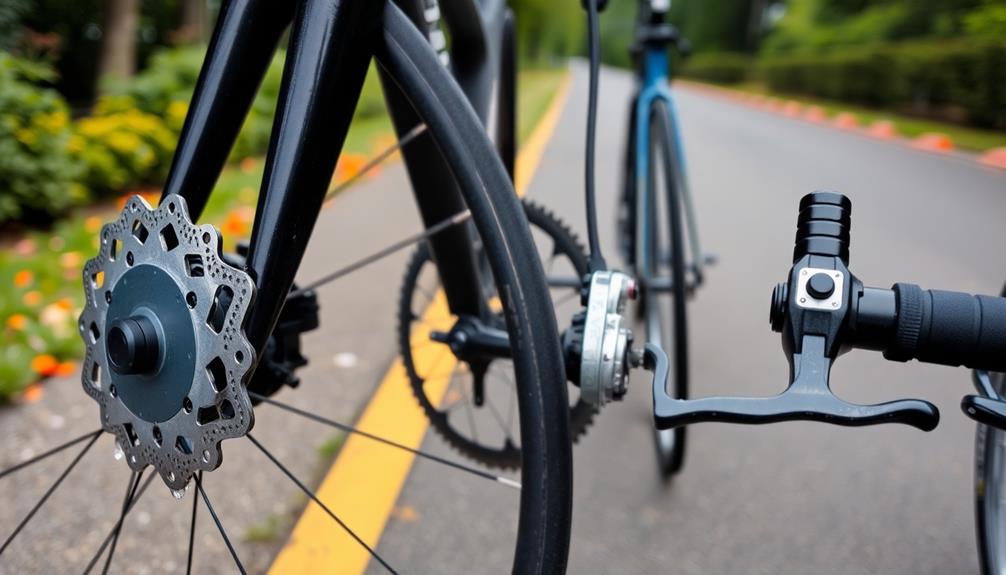
When choosing your hybrid bike, you'll want to evaluate the brake types that best suit your riding style.
Rim brakes are lightweight and easy to maintain, making them a popular choice for casual riders. However, disc brakes offer superior performance, especially in wet conditions, providing better stopping power and control.
Consider the weather and terrain you'll encounter most often to make the right choice for your safety and control.
Additionally, just as with selecting an eco-friendly heating option like a wood stove, it's important to assess how each option impacts your overall experience and environmental footprint, including environmental benefits of wood stoves.
Rim Brake Advantages
Why choose rim brakes for your first hybrid bike? Rim brakes are a popular choice for entry-level cyclists due to their lightweight design and lower cost compared to disc brakes. If you're riding mainly on paved surfaces in dry conditions, you'll appreciate the effective stopping power they offer. These brakes perform well in the environments most hybrid bike riders frequent, making them a practical option.
Additionally, rim brakes provide a straightforward setup that can be beneficial for new riders who may not have experience with more complex systems, like those found in top US truck manufacturers.
Another advantage is the ease of maintenance. Rim brakes require less technical knowledge and are simpler to adjust than disc brake systems, which can be complex. This means you can focus more on riding and less on repairs.
However, keep in mind that rim brakes do require more frequent replacement of brake pads, especially if you ride often in wet conditions. Water can reduce friction, leading to longer stopping distances, but for your average commuter, this mightn't be a significant concern.
Disc Brake Benefits
Providing superior stopping power and modulation, disc brakes stand out as a top choice for hybrid bike riders, especially those tackling varied terrains or wet conditions. Unlike rim brakes, disc brakes perform consistently, guaranteeing you can stop effectively, even when the roads are muddy or slick.
Additionally, proper maintenance of your equipment, like confirming your tires and brakes are in good condition, can greatly enhance your biking experience, especially when maneuvering trails or camping areas. Regular maintenance can extend the life of the canvas and keep it dry.
Hydraulic disc brakes, in particular, require less finger effort to operate, making your rides more comfortable, especially on long descents or steep climbs.
Additionally, the use of disc brakes allows for larger tires on your hybrid bike, enhancing grip and comfort while maneuvering different surfaces. This means you can enjoy a smoother ride without sacrificing performance.
Whether you opt for hydraulic or mechanical disc brakes, both options offer reliable stopping power and ease of maintenance. Mechanical disc brakes can be easily adjusted without specialized tools, making them user-friendly for beginners.
Ultimately, the benefits of disc brakes—consistent braking, superior grip, and the ability to handle diverse conditions—make them an excellent choice for any hybrid bike enthusiast. As you explore your options, consider how disc brakes can elevate your riding experience and guarantee your safety on various terrains.
Weather Performance Considerations
Choosing the right brake type for your hybrid bike can greatly impact your riding experience, especially in varying weather conditions. When evaluating brakes, consider how they perform in rain or wet conditions.
Disc brakes are generally superior to rim brakes, providing consistent stopping power regardless of the weather. This means you'll enjoy better safety and performance when riding in challenging terrains. Additionally, selecting a bike that features best beach gear can enhance your overall outdoor experience, making it easier to transport your essentials during rides.
If you're choosing a hybrid bike, you'll need to decide between hydraulic and mechanical disc brakes. Hydraulic disc brakes require less finger effort and offer better modulation, making them a reliable choice in wet conditions. On the other hand, mechanical disc brakes may need manual adjustments, which could be a hassle during rainy rides.
Maintenance is another significant factor. Rim brakes can wear out faster in wet conditions due to water accumulation, leading to more frequent repairs. In contrast, disc brakes typically require less maintenance and have lower long-term costs, as they're less affected by water and debris.
Ultimately, for those living in regions with frequent rain or rough terrains, opting for hybrid bikes with disc brakes is a smart choice that enhances your safety and performance.
Setting Your Budget

When setting your budget for a hybrid bike, it's important to take into account not just the bike itself but also the additional expenses that come with it. Entry-level hybrid bikes typically start around $300, while higher-quality bikes begin at approximately $500.
Investing in a higher-quality bike often leads to better long-term performance and lower maintenance costs, making it a more economical choice over time.
Don't forget to factor in additional costs like necessary accessories, which can add another $100 to $300 to your total expenditure. These accessories are vital for a safe riding experience.
If you're working with a tight budget, consider exploring second-hand options. You can find many used models in excellent condition, allowing you access to higher-quality bikes without breaking the bank.
Timing your purchase can also save you money. The best time to buy a hybrid bike is typically at the end of the cycling season, around September or October, when retailers often offer discounts to clear out inventory.
Essential Accessories for Safety
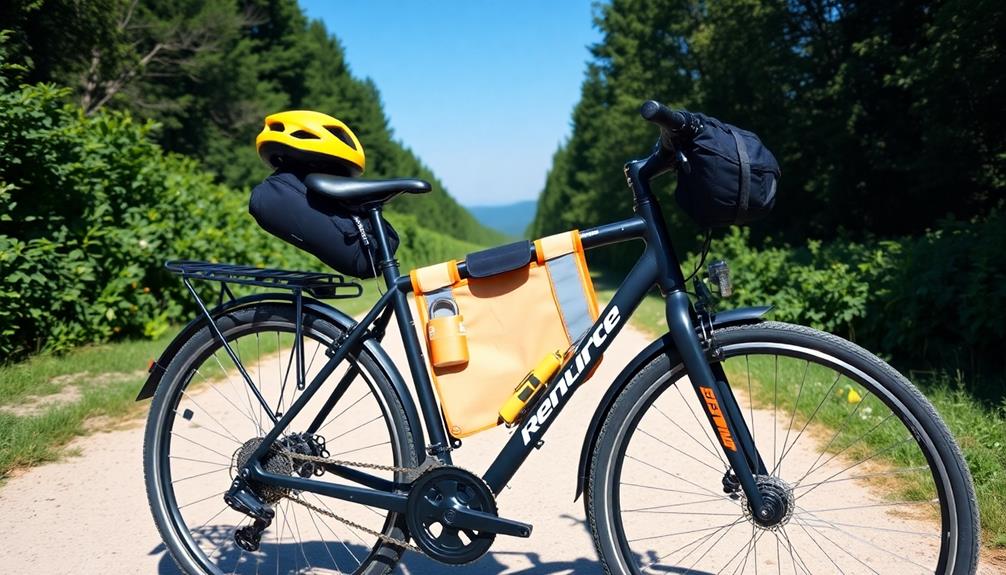
Safety should be your top priority when riding a hybrid bike, and equipping yourself with the right accessories can make all the difference.
Start with a properly fitted helmet; it reduces the risk of serious injury by about 85% in a crash. Next, invest in front and rear bike lights—studies show they can increase your visibility by up to 19 times, greatly lowering the risk of accidents in low-light conditions.
Don't overlook reflective gear, such as vests or bands, which enhance your visibility to other road users during both day and night rides.
For comfort on longer rides, padded cycling shorts are essential; they help reduce friction and prevent chafing, making your riding experience much more enjoyable.
Lastly, carry a basic repair kit that includes tire levers, a multi-tool, and a pump. This kit is vital for handling minor issues on the road and guarantees a hassle-free experience.
Frequently Asked Questions
Are Hybrid Bikes Good for Beginners?
Absolutely, hybrid bikes are great for beginners! They offer comfort with an upright position, stability, and easy handling. With versatile features and low maintenance needs, you'll find riding enjoyable and manageable on various terrains.
What Are the Disadvantages of Hybrid Bikes?
Hybrid bikes have some disadvantages. They're heavier, which can slow you down. Their wider tires may create more resistance, and lower-quality components can lead to quicker wear. They may also lack advanced suspension for rough trails.
What Features Should I Look for in a Hybrid Bike?
When you're picking a hybrid bike, think of it as choosing a trusty companion for your adventures. Look for a lightweight frame, suitable wheel size, reliable gears, strong brakes, and comfort features for enjoyable rides.
How Should You Fit on a Hybrid Bike?
To fit on a hybrid bike, adjust the seat height so your legs bend slightly at the lowest pedal position. Make certain handlebars align with your comfort level, promoting an upright posture for longer rides. Test ride for best comfort.
Conclusion
Choosing your first hybrid bike is like selecting the right pair of wings. Each feature, size, and gear reflects your unique journey, empowering you to explore new paths and embrace adventure. As you set your budget and gather essential accessories, remember that every ride symbolizes freedom and discovery. So, gear up and let your bike be the bridge that connects you to the world, inviting you to pedal into experiences that shape who you are.
